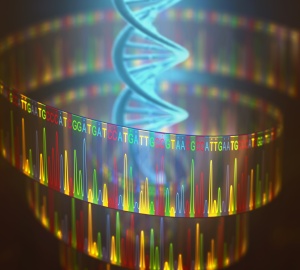
Next-generation sequencing (NGS) is a revolutionary genomic sequencing technology that allows researchers and clinicians to quickly and cost-effectively analyse large quantities of genetic material in a single experiment. NGS can rapidly identify disease-causing pathogens and cancer-causing mutations in patients’ genetic information faster and with more detail than ever before.1
Scientists working in various fields, from genomics and transcriptomics to personalised medicine and gene sequencing, benefit from using NGS. This high-throughput sequencing technology is vital for advancing research towards lifesaving new diagnoses and treatments.1,2
How does next-generation sequencing (NGS) work?
NGS can sequence thousands of genes at once, and even the entire human genome, providing a wealth of valuable information about biological systems. It can analyse complex genetic variations, like single nucleotide polymorphisms (SNPs), insertions, deletions, and structural variations.2
NGS works by breaking down DNA or RNA or into millions or billions of short fragments. These pieces are amplified and analysed simultaneously, using bioinformatics to map them to a reference genome.3 The pieces are then assembled like a jigsaw to reconstruct the original genetic material, providing an unprecedented level of sequencing information in less time and for a lower cost than previous methods.
NGS: The new gold standard for genomic sequencing
The predecessor of NGS is Sanger sequencing which, whilst being an effective tool for genomic analysis, only analyses one fragment at a time and is typically limited to detecting small insertions, deletions and substitutions.4 In comparison, NGS sequences lots of small fragments in parallel, generating orders of magnitude more data than Sanger sequencing.
Traditionally, researchers needed other methods to detect mutations not picked up by Sanger sequencing, like fluorescence in-situ hybridisation (FISH) and comparative genomic hybridisation (CGH). Now, NGS circumvents the need for these techniques by allowing scientists to analyse a large amount of genomic data in a single assay.
On top of this, NGS is much more sensitive than other genomic analysis tools. It provides more detail than methods like microarray gene expression measurements and can reveal hard-to-detect genomic phenomena like mosaic mutations that are typically missed by methods like capillary sequencing.
NGS is a game-changer for oncology and microbiology
NGS has advanced our ability to understand the genetic basis of diseases and the diversity of microbial communities. Today, researchers worldwide use NGS for genome sequencing, gene expression profiling, identifying genetic variants, detecting disease-causing mutations, and studying the microbiome, among many other applications in oncology and microbiology.
This is exceptionally valuable in clinical oncology, where NGS allows scientists to examine entire cancer genomes simultaneously. The International Cancer Genome Consortium has analysed 25,000 cases since 2007. Their groundbreaking work in genomic oncology has expanded our understanding of cancer biology and assisted the discovery of novel cancer-driver genes.1 NGS is ideal for such research as it provides vast amounts of genetic information. A conventional tool like capillary sequencing is limited to analysing small numbers of samples and genes. NGS helps to enable more precise cancer diagnosis and classification and may also help researchers to identify ‘druggable’ mutations, which is a vital step towards personalised medicine.5
Scientists also use NGS to analyse microbial pathogens like methicillin-resistant Staphylococcus aureus (MRSA), rather than relying on traditional morphology analyses and staining techniques. Researchers used NGS to trace an outbreak of MRSA in a UK hospital that was not revealed by conventional microbial analysis, demonstrating the sheer power of NGS as an analytical tool.
NGS solutions from Cambridge Bioscience
Cambridge Bioscience offers an exciting portfolio of products for the entire NGS workflow. We work with specialist NGS suppliers to generate better, more meaningful sequencing data for various NGS applications.
We provide library preparation kits for DNA sequencing, RNA sequencing, and epigenetic sequencing. To learn more about our NGS products, please don’t hesitate to contact a member of Cambridge Bioscience for more information.
References and further reading
- Aburatani, H., 2019. S5-KL-1 CANCER GENOMIC MEDICINE: FROM BENCH TO CLINIC. Neuro-oncology Advances, 1(Suppl 2), p.ii4.
- Hayes, M., 2019. Computational Analysis of Structural Variation in Cancer Genomes. Cancer Bioinformatics, pp.65-83. Hosseini, S.S. (2016). Bioinformatics pipeline development to support Helicobacter pylori genome analysis
- Herman, S., Varga, D., Deissler, H.L., Kreienberg, R. and Deissler, H., 2012. Medium-sized deletion in the BRCA1 gene: limitations of Sanger sequencing and MLPA analyses. Genetics and molecular biology, 35, pp.53-56.
- Kamps, R., Brandão, R.D., van den Bosch, B.J., Paulussen, A.D., Xanthoulea, S., Blok, M.J. and Romano, A., 2017. Next-generation sequencing in oncology: genetic diagnosis, risk prediction and cancer classification. International journal of molecular sciences, 18(2), p.308.
- Kamps R, Brandão RD, Bosch BJ, Paulussen AD, Xanthoulea S, Blok MJ, Romano A. Next-Generation Sequencing in Oncology: Genetic Diagnosis, Risk Prediction and Cancer Classification. Int J Mol Sci. 2017 Jan 31;18(2):308. doi: 10.3390/ijms18020308. PMID: 28146134; PMCID: PMC5343844.
